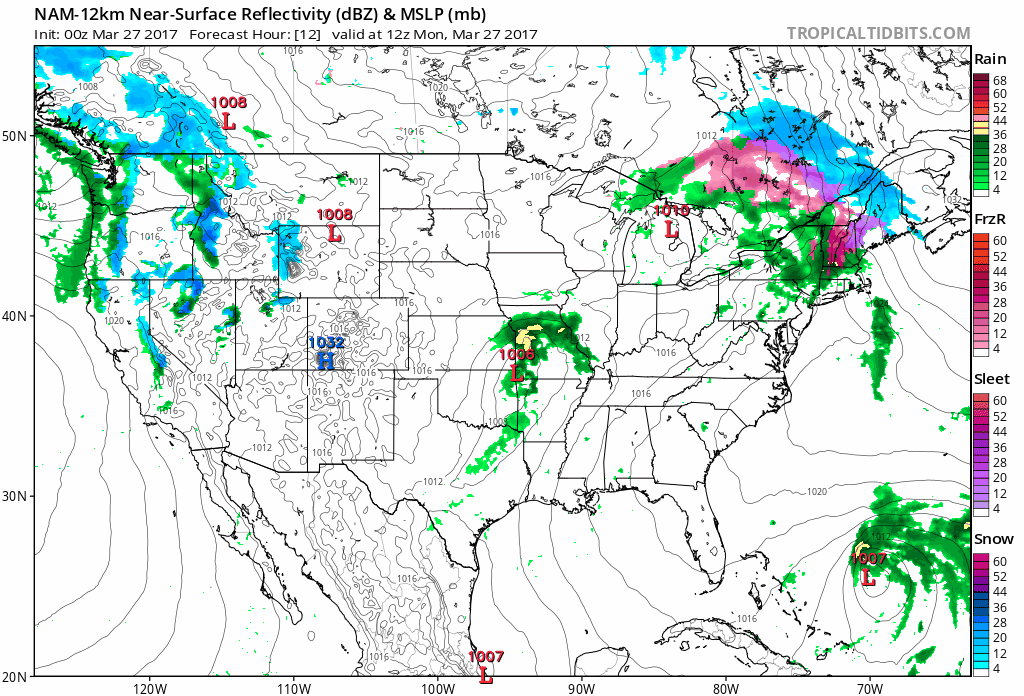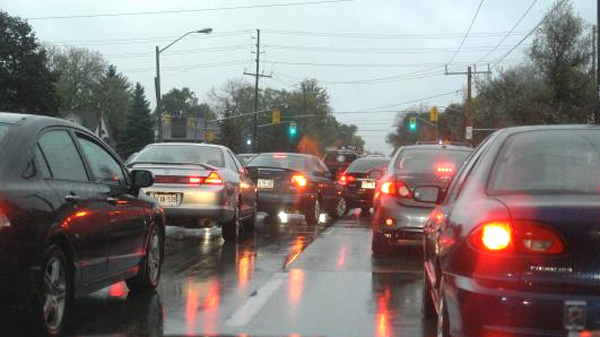44 F. maximum temperature yesterday at MSP.
47 F. average high on March 26.
51 F. high in the cities on March 26, 2016.
March 27, 1946: A record high of 78 is set at Redwood Falls.
Spring Is In No Particular Hurry This Year
"A mentor is someone who sees more talent and ability within you, than you see in yourself, and helps bring it out of you" wrote Bob Proctor.
It's strange how careers get started. For me in was study hall (which I excelled in) my senior year of high school. One of my classmates had his own show on a little AM radio station in town. I tapped him on the shoulder. "Why not have your own weather guy on the air?" I asked, impulsively. He thought about it, put me on the phone to his boss, and that would be the first of nearly 100 radio stations I've been on over the years, from Pennsylvania to Minnesota.
Bob Roerig, the friend who took a chance on me, died of a massive heart attack. Be sure to thank the people (teachers, mentors, parents, etc) who gave you your first shot.
I'm conflicted: I want it to warm up as much as you do, but spring warm fronts are often serenaded by thunder and shrieking sirens. The south will see a series of severe weather outbreaks this week; just brushing Minnesota with showers late Wednesday into Thursday.
No quality time in your basement anytime soon. At least the sun comes on Tuesday with 60F possible next Sunday!
Tornado-Producing Squall Line.
The visible image above shows the comma-shaped swirl of low pressure
that created enough wind shear to spin up rotating supercell
thunderstorms capable of softball-size hail Sunday evening from north
Texas into Oklahoma. Imagery: College of DuPage.

Seattle Blues - Another Midweek Severe Outbreak.
12 KM NAM model guidance from NOAA shows a steady fire hose of Pacific
moisture pushing more waves of moderate rain into the Pacific Northwest,
while a deep trough of low pressure sets the stage for more severe
weather over the central and southern Plains by Wednesday. Animation:
Tropicaltidbits.com.
Creeping Into Spring.
No hot spikes, not even a serious warm front, but ECMWF guidance hints
at MSP metro highs near 60F on Tuesday; fairly consistent highs in the
50s over the next 15 days. Meteogram: WeatherBell.
Mammoth Got So Much Snow This Winter It Called In the National Guard for Help. Amazing. The Los Angeles Times has details: "Hey, Mammoth Lakes,
add this group shot of the National Guard to your winter scrapbook.
Burdened with removing the 44 feet of snow that had fallen this season,
the village of 8,200 called in the National Guard earlier this month to
help cart 4,000 tons of it away. The five-day offensive, involving 17
air and Army troops, will be just one of the many memories in this
winter of monster, record-setting snows. The SOS — shovel our snow — was
issued after the village and Mono County declared a state of emergency
to seek help in handling the piles that lined homes and streets. A
request for snow removal assistance was passed along to the state Office
of Emergency Services (Cal OES), which then called in the Guard..."
More Warm Spring Days. Not every day, but the trend is more warmth earlier in the warm season, according to Climate Central: "...Spring is getting warmer, on average, as the globe heats up from the increase in greenhouse gases in the atmosphere. As a result, the number of spring days with above-normal temperatures is increasing in many places in the U.S. In an unchanging climate, the number of days above normal and below normal should be relatively balanced and constant through the years. For meteorological spring, that number would be 46 out of the 92 days. In the majority of these cites, the number of days above normal has risen sharply. In some cases, there are more than 10 additional above-normal days than there were a few decades ago..."



Photo credit: "The March 6 storm that did some heavy damage to the county’s Pihl’s Park, including flipping this camper over, was designated as a tornado that first touched down near Bricelyn and traveled nearly 10 miles to near the Wells area. It was designated by the National Weather Service last week as the earliest-in-the-season tornado ever reported in Minnesota."
Image credit: "When a tornado is fully formed, the simulation reveals several structures that make up the tornado, including the streamwise vorticity current (SVC), thought to be a main driver of the tornadic activity (seen in yellow)." (Photo: University of Wisconsin-Madison).
CBS Affiliate in Ohio Cut Away from UNC-Kentucky Finish for Tornado Warning. Talk about bad timing. The Washington Post reports.
Image credit: "Erik Rasmussen, VORTEX-SE project manager and NOAA senior research scientist, speaks about the research at Signature Aviation with a NOAA Lockheed WP-3S Orion aircraft in the background. The WP-35, nicknamed Kermit, has been brought to Huntsville to support VORTEX-SE."
Solar Employs More People in U.S. Electricity Generation Than Oil, Coal and Gas Combined. Here's a clip from The Center for Climate Protection: "In the United States, more people were employed in solar power last year than in generating electricity through coal, gas and oil energy combined. According to a new report from the U.S. Department of Energy, solar power employed 43 percent of the Electric Power Generation sector’s workforce in 2016, while fossil fuels combined accounted for just 22 percent. It’s a welcome statistic for those seeking to refute Donald Trump’s assertion that green energy projects are bad news for the American economy. Just under 374,000 people were employed in solar energy, according to the report, while coal, gas and oil power generation combined had a workforce of slightly more than 187,000. The boom in the country’s solar workforce can be attributed to construction work associated with expanding generation capacity. The gulf in employment is growing with net generation from coal falling 53 percent over the last decade. During the same period, electricity generation from natural gas increased 33 percent while solar expanded 5,000 percent..."
Drake Equation Revision Hugely Ups Odds Intelligent Extraterrestrial Life Exists.
Maybe so, but where are the aliens? Could it be they've sampled our TV
shows (or politics) and want nothing to do with us? Here's an excerpt
from Inverse: "Mankind
doesn’t explore space solely in search of extraterrestrials, but we
keep our eyes peeled. Still, scientists know that the chances of
happening across a fellow traveler in the great beyond are minimal — and
they wrap their heads around the infinitesimal odds using the Drake Equation,
a seven-variable way of deriving the chance of active civilizations
existing beyond Earth. But equations get older and equations get wrong.
The Drake Equation, which takes into account various factors like the
rate of star formation, the fraction of stars that could form planetary
systems, the number habitable planets in those systems, and so on, is
now 55 years old. It doesn’t reflect the new information SETI
researchers have collected since the 1960s..."
"Sea of Despair" Among White, Working-Class Americans. Industries are being disrupted, jobs automated; companies making do with fewer employees. A Washington Post article claims it's not just blue collar America that's feeling the heat: "Sickness
and early death in the white working class could be rooted in poor job
prospects for less-educated young people as they first enter the labor
market, a situation that compounds over time through family dysfunction,
social isolation, addiction, obesity and other pathologies, according
to a study published Thursday by two prominent economists. Anne Case and Angus Deaton garnered national headlines in 2015 when they reported
that the death rate of midlife non-Hispanic white Americans had risen
steadily since 1999 in contrast with the death rates of blacks,
Hispanics and Europeans. Their new study extends the data by two years
and shows that whatever is driving the mortality spike is not easing up.
The two Princeton professors say the trend affects whites of both sexes
and is happening nearly everywhere in the country..."
Can We Know What Animals Are Thinking?
My dog (Leo) thinks I'm pretty stupid (and predictable), but he loves
me anyway. Here's an excerpt of an eye-opening story from The Economist
and Medium: "...Nevertheless,
most scientists now feel they can say with confidence that some animals
process information and express emotions in ways that are accompanied
by conscious mental experience. They agree that animals, from rats and
mice to parrots and humpback whales, have complex mental capacities;
that a few species have attributes once thought to be unique to people,
such as the ability to give objects names and use tools; and that a
handful of animals — primates, corvids (the crow family) and cetaceans
(whales and dolphins) — have something close to what in humans is seen
as culture, in that they develop distinctive ways of doing things which
are passed down by imitation and example. No
animals have all the attributes of human minds; but almost all the
attributes of human minds are found in some animal or other..."
Photo credit: "Streaming and mobile video has made it so much easier to binge." (AP/Eric Charbonneau/Invision for Showtime).

TODAY: Lingering clouds, cool. Winds: NE 5-10. High: 49
MONDAY NIGHT: Partly cloudy. Low: 34
TUESDAY: Partly sunny, springy again. Winds: E 5-10. High: 56
WEDNESDAY: Clouds increase, showers late. Winds: E 8-13. Wake-up: 39. High: 52
THURSDAY: Damp, showery start, slow PM clearing. Winds: NE 8-13. Wake-up: 40. High: 51
FRIDAY: Plenty of sun, your yard beckons. Winds: NE 7-12. Wake-up: 33. High: 54
SATURDAY: Fading sun, rain may stay south of MN. Winds: SW 5-10. Wake-up: 37. High: 56
SUNDAY: Partly sunny, feels like April. Winds: NE 5-10. Wake-up: 41. High: near 60
Climate Stories...
What You Can Do About Climate Change. There are lots of things you can do, including voting for pro-science politicians running for local, state and national offices. An article at The New York Times argues that the most important thing you can do is drive a more fuel-efficient vehicle: "...The simple fact is that American drivers are a significant contributor to greenhouse gas pollution, so having a vehicle fleet that burns less fuel can have an outsize impact on total emissions. Though the United States has just 4 percent of the world's population, it is responsible for 14 percent of man-made greenhouse gases that end up in the atmosphere. Transportation accounts for 27 percent of those emissions. And 60 percent result from driving personal vehicles..."
Climate Change Signal in Great Plains Wildfires? Is the unusual warmth that helped to create conditions favorable for record wildfires over the southern Plains related to background warming, or just a random event? Here's an excerpt from Climate Signals: "...Since the 1970s, large grass and shrubland fires have increased by more than 100,000 acres per decade. The frequency and intensity of wildfires in the Great Plains are increasing as the combination of higher temperatures, untamed underbrush and more extreme drought elevate wildfire risk. Formal attribution work has identified the fingerprint of global warming in the record hot temperatures that swept across the US east of the Rockies in February 2017, as climate change increased the likelihood of such heat by threefold. The heat fueled worsening drought conditions in the Great Plains region, contributing to the extreme fire conditions in early March that precipitated major blazes in Kansas, Oklahoma, Colorado, and Texas. One blaze, encompassing Clark and Comanche counties along Kansas' southern border with Oklahoma, is the largest wildfire on record in the state..."
Global Warming is Increasing Rainfall Rates. Here's an excerpt of a story from Dr. John Abraham at the University of St. Thomas, writing for The Guardian: "...In my state, we have had four 1000-year floods since the year 2000! Two years ago, Minneapolis, Minnesota had such flooding that people were literally fishing in the streets as lakes and streams overflowed and fish escaped the banks. No joke, I actually observed fish swimming past me as I waded up a street. This occurrence is being observed elsewhere in my country and around the world. It falls upon city planners and engineers to design infrastructure that is more able to accommodate heavy rains and manage water. This means designing river containment areas or flood plains, reinforcing buildings and houses, and increasing the capacity of storm drainage in urban areas, just to name a few. These modifications present costs but not preparing for increased flooding poses even greater financial and social costs. Moreover, storing water from times when there is too much for the inevitable times when we have too little (drought), results in better water management and multiple benefits..."
Photo credit: "Jared Bakko hauls a boat down a flooded road after taking supplies to his grandmother as the Red River flood waters began to recede just south of Moorhead, Minnesota, USA, 28 March, 2009." EPA/CRAIG LASSIG Photograph: Craig Lassig/EPA.
Photo credit: "Spring is arriving earlier, and the vernal window is lasting longer." ellenm1 / Flickr, http://michrad.io/1LXrdJM.
I grew up in South Dakota, where it seems to be windy a lot. I didn't miss that when I moved to MN, and I admit I'm a bit annoyed at the obnoxious winds lately. However, I do associate higher constant winds with the influx of warm weather in the spring. Also, somewhat with the incoming colder temperatures in the fall. In the Twin Cities, it's interesting that we're seeing higher average winds in Feb. and April, and lower than ave. in May. Similarly, we're seeing higher winds in Nov. and lower in Oct. Does this hint at a correlation with the shifting of the seasons to earlier warming and later cooling?
ReplyDeleteAlso, I just discovered an electric riding lawn mower at Home Depot this weekend. Since a Tesla is still out of my price range, I'm tempted to replace my gas mower with an electric one. Maybe next year...